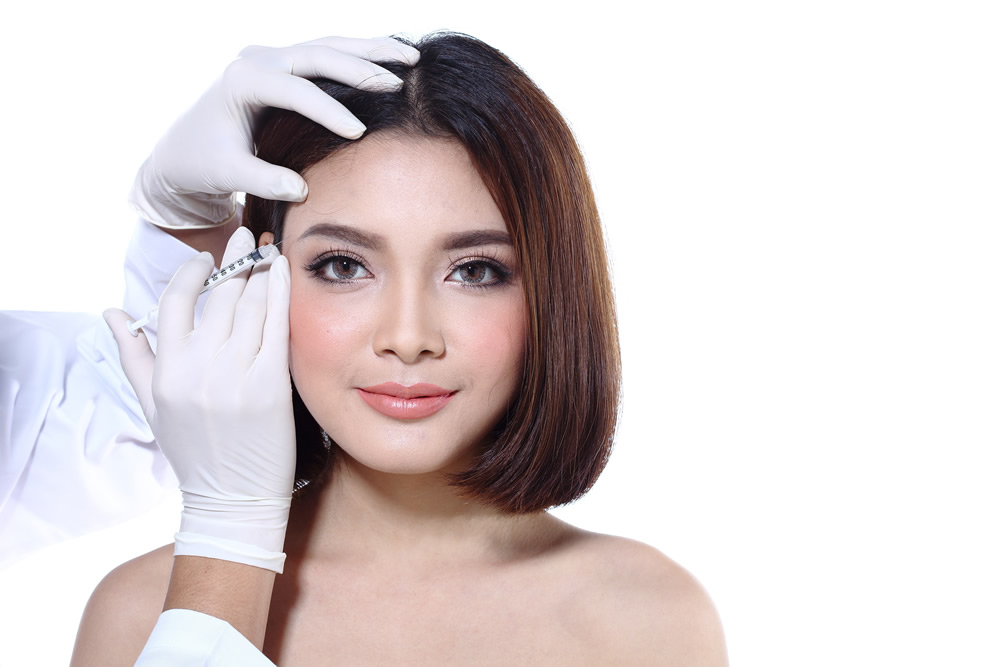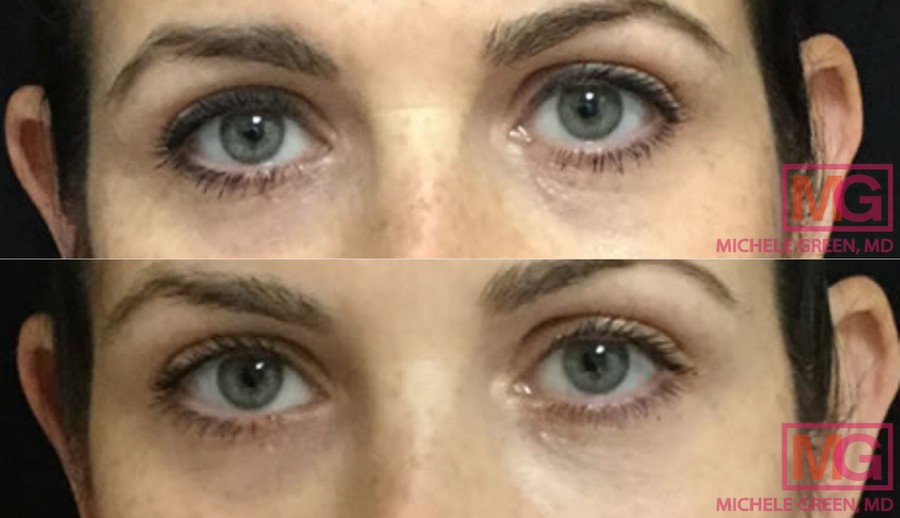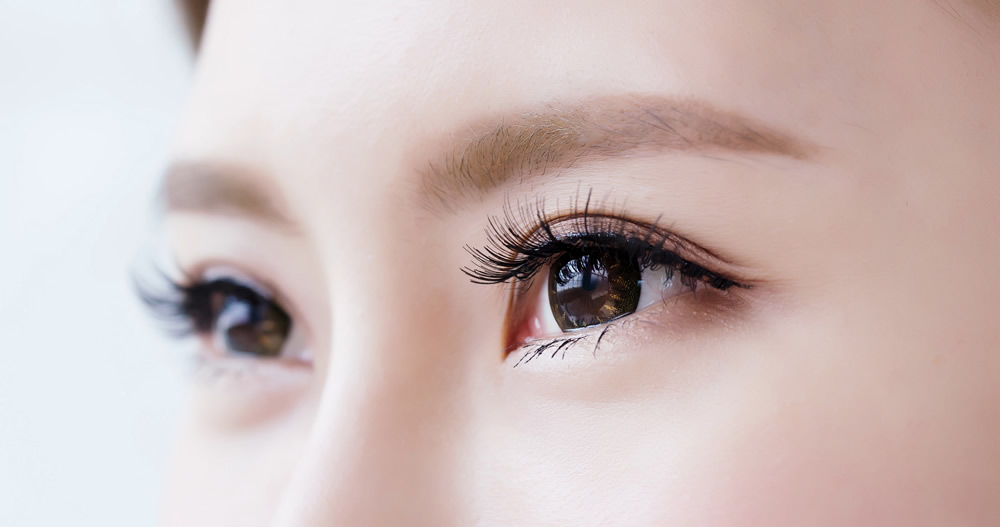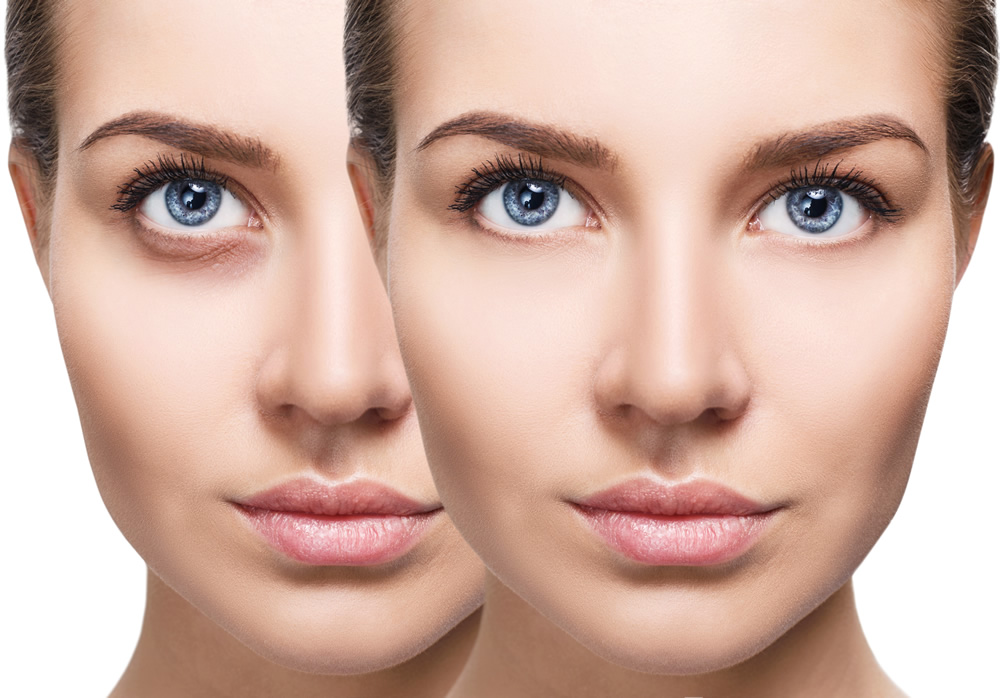How to Treat Dark Circles Under Your Eyes

We’ve all had a day where we’ve woken up less than well-rested, only to see dark circles appear under our eyes. For some, this is a minor issue that pops up every now and again but, for many patients, dark under-eye circles, under eye puffiness, and under-eye bags can be a constant issue. Whether it’s a natural genetic trait or it has been exacerbated by the natural aging process, dark circles under the eye can force patients to feel as though they look less energized, youthful, or radiant.
There are a variety of treatment options which Dr. Michele Green has perfected, as an expert in New York in cosmetic dermatology, which can help you improve the look of your tired eyes. Whether the problem is the appearance of dark shadows under the eyes, under-eye bags, puffy eyes, or fine lines and wrinkles around the eyes, Dr. Green has specific rejuvenating treatments to improve each of these cosmetic issues. Each treatment is designed to help revitalize the look of the eyes by either targeting the underlying cause to treat dark circles or, if the cause is genetic, lightening the appearance of dark circles, boosting collagen, or helping to revitalize thin skin in the eye area.
If you’re frustrated by the appearance of dark under-eye circles, board-certified cosmetic dermatologist Dr. Michele Green is here to help. Whether it be the best skin care, Botox injections, dermal fillers, chemical peels, skin lightening, microneedling, or laser treatments, Dr. Green will help to restore and improve the appearance of dark circles under the eyes, under eye hollows, or hyperpigmentation. With over 25 years of experience as one of the best cosmetic dermatologists in NYC, Dr. Green will review the underlying cause of your dark circles and construct the best treatment plan to remove your dark under-eye circles.
Causes of dark circles under the eyes
Many patents ask “What causes dark under-eye circles”? The answer tends to vary from person to person. Dark under-eye circles are common among both men and women, and are more common in patients who are elderly, have a darker skin tone, or who have a genetic predisposition to dark shadows under the eyes (known as periorbital hyperpigmentation). Dark circles and puffiness under the eyes can be caused by a variety of genetic and environmental factors. Common causes include lack of sleep, age, eye strain, allergies, intense sun exposure, and dehydration.
Family history can be a primary cause of discoloration under the eyes, particularly amongst patients who have a genetic predisposition towards thyroid disease or other medical conditions which can be associated with dark under-eye circles. However, for some, dark circles under the lower eyelids are simply an inherited trait that can develop in early childhood. For others, environmental factors or lifestyle habits are more likely to be the culprit. For example, those who don’t get enough sleep–or those who oversleep–often notice that their skin appears duller and paler, which can expose the blood vessels and dark pigmented tissues beneath the skin’s surface. This duller appearance to the skin is also common amongst patients who do not drink enough water daily and tend to be dehydrated.
For other patients, darker pigmentation under the eyes can be due to sun exposure, which can lead to excess melanin production in the body, thus darkening the pigment of the skin under the eyes. Eye strain is also a common cause of dark under-eye circles, as staring at blue light (what a computer, TV, or phone typically emits) can cause the eyes to become irritated, which in turn can enlarge the blood vessels around the eyes, thus leading to a darker appearance under the eye. Allergic reactions and a history of atopic dermatitis and eczema and dry eyes can also trigger dark circles, though typically an over-the-counter antihistamine can limit an allergic reaction in the eye area.

Before and After Restylane under eyes
Are dark circles permanent?
For many patients, dark circles can be treated through improvements in lifestyle. For example, patients who prioritize a good night’s sleep, hydrate or protect against eye strain tend to see the appearance of dark circles dissipate over time. However, patients who suffer from chronic under-eye circles may not see improvement through just changes in lifestyle alone. In particular, patients who are dealing with allergic reaction will likely need some sort of medication to reduce the appearance.
In the case of patients who have a genetic predisposition to dark under-eye circles, darker pigment under the eyes can be difficult to eliminate. Additionally, patients who develop dark circles due to the natural aging process are unlikely to see under-eye circles disappear on their own. However, there are means to reduce the appearance of dark circles through in-office procedures and changes to skincare routines. For some patients, certain skincare products, moisturizers and vitamins can help to reduce the appearance of dark circles and, for others, dermal fillers or mesopeels may help to reduce under-eye discoloration. Mesopeels are particularly beneficial for patients who are looking to reduce the effects of pigmentation, melanin, and sun exposure on the skin surrounding the eyes.
How to get rid of dark under-eye circles
The best way to get rid of dark under-eye circles is to determine the cause of the discoloration, and develop a treatment plan that targets the source of the dark circles. For some patients, this may mean drinking more water, using eye drops, or taking a regular antihistamine. For others, this may mean adjusting a skincare regiment or engaging in rejuvenating eye treatments, Botox®, or dermal fillers such as Restylane®, Belotero, or Juvederm®, to restore the skin to its former brightness. When you work with Dr. Green, she’ll be able to pin point which treatment options will best meet your needs, and develop a treatment plan optimized for your specific skin.
How do dermal fillers worked to treat dark under eye circles?
Oftentimes, the primary cause of dark under eye circles is the natural loss of collagen that happens in the face during the aging process. As we age, our skin can lose its fullness or sag, leading to thin or translucent skin under the lower eyelid. Additionally, some patients naturally have a more hollow appearance under the eyes, which can give off the appearance of dark circles due to shadows under the eye. Dermal fillers are designed to restore collagen production and volume to the treatment area, and can be injected into the tear trough area (under the eyes) to restore lost volume and help to reduce the appearance of darker pigment under the eyes.
For under-eye treatment, Dr. Green typically recommends the use of Restylane or Belotero Balance dermal fillers, which are both hyaluronic acid dermal fillers with a small particle size. Hyaluronic acid is a naturally-occurring substance in the body that helps aid collagen production to create more youthful-looking skin. Dermal fillers under the eye can create natural looking volume restoration, reducing the appearance of fine lines, puffiness, and dark circles.
Mesopeels and dark under eye circles
A mesopeel is a light chemical peel that is designed to rejuvenate the skin under the eyes through a series of light chemical peels, with absolutely no down time. Essentially, a Mesopeel is able to remove discoloration by removing dead skin cells of the top layer of the dermis, revealing healthy new skin underneath, through rejuvenating ingredients. The Mesopeel Periocular is a popular in-office treatment to treat under-eye circles and wrinkles in the eye area. The peel itself is composed of azelaic acid, citric acid, lactic acid, physic acid, resorcinol, and salicylic acid which all combine to reduce fine lines and wrinkles, hyperpigmentation, and discoloration under the eyes. It’s a non-invasive chemical peel which requires no downtime, and can lead to excellent, all-over eye rejuvenation and safe to treat all skin tones.
Vbeam laser treatment for blood vessels under eyes
The Vbeam laser is an innovative skin resurfacing laser that is designed to reduce the appearance of redness and pigmentation of the skin. It is a pulsed dye laser which utilizes laser energy at a wavelength of 595 nanometers (nm) that passes through the superficial layers of the skin and is absorbed by the hemoglobin in the blood vessels themselves, and not the skin. In this way, the Vbeam laser can treat broken blood vessels, rosacea, acne, acne scars, and sun damage or pigmentation. The Vbeam is designed to be safe to use on patients with sensitive skin, and is often used in the treatment of rosacea and eczema. When applied to the under-eye area, the V-beam laser is able to reduce the size of enlarged blood vessels, which can help to reduce the appearance of dark pigment under the surface of the skin. Additionally, Dr. Green uses the newest V-Beam laser technology, the V-Beam Perfecta, which offers additional success in reducing the appearance of sun spots, discoloration due to sun exposure.
Microneedling to treat dark circles
An excellent way to reduce the appearance of dark under-eye circles is through the use of microneedling, also known as collagen induction therapy. Microneedling is a non-invasive treatment option that uses tiny pinpricks to activate the body’s natural wound-healing processes, thus leading to increased collagen production and rejuvenated skin. Microneedling can be combined with platelet-rich plasma (PRP) to use a patient’s own growth factors and nutrients to further nourish and revitalize the skin. As Dr. Green explains in her interview with RealSelf, “Growth factors are what our cells use to heal and regenerate healthy tissue, so this procedure is great for the under-eyes, to correct superficial lines and wrinkles.”
One of the most popular devices used for microneedling is Vivace RF Microneedling, which incorporates radiofrequency energy to simultaneously boost collagen and elastin within the dermis. Over the course of three treatments spaced four weeks apart, patients can see a brightening effect on the skin, as well as a reduction of fine lines and puffiness around the eyes.
What is the best way to remove dark circles from your under eyes?
When it comes to removing dark circles from under-eyes, there are a variety of options that patients can rely on. From dermal fillers to mesopeels, from lasers to topical treatments, patients have a myriad of options to reduce the appearance of discoloration or sagging in the eye area. Though each different approach has its own benefits, there is no one “best” way to remove dark circles from under the eyes. The cause of the dark circle must be established in order to match the best treatment option with it. Dr. Green offers a variety of different methods to treat dark under-eye circles in order to best fit the needs of each patient, and each treatment plan is custom tailored to support your current skin condition, medical history, and aesthetic goals.

How to get rid of dark circles naturally: Which home remedies work?
When it comes to treating dark circles at home, there are a few topical treatment options that can help. Though not all skincare products are created equally, there are some active ingredients in the world of health care and dermatology that are considered safe and affective in treating discoloration or dark pigment on the skin. A great starting point for many patients is to use a cold compress (using a gentle washcloth) over the eyes to help constrict blood vessels, or eye gel masks, to calm the eye area. From there, many patients will compliment in-office treatments with routine skincare that can help to further improve under-eye results.
Tea Bags to treat dark under eye circles
Some patients have found success using the application of tea bags on the eyes ignorer to reduce the appearance of dark circles under the eyes. Caffeine is a commonly-used ingredient to perk up the look of the eye area, and the antioxidants that are found in many black and green tea varieties is thought to improve blood flow to the area under the eyes. Additionally, tea has a naturally anti-inflammatory affect, which can help to reduce puffiness. Green tea is also a commonly used ingredient in certain face masks and moisturizers due to its powerful antioxidants.
Which ingredients in eye creams should you look for to improve dark under eye circles?
In convenience store aisles and commercials, patients are bombarded with advertisements of “miracle creams” that have “overnight results,” and unfortunately, these creams can often be misleading. However, creams with useful active ingredients can in fact make a difference with regular use. Dr. Green’s MGSKINLAB’s Intensive Eye Repair is one such product. Dr. Green has used her pivotal knowledge in skin nourishing treatments to develop her eye creams. Her intensive eye repair relies on retinol to create a cooling gel that reduces fine lines, puffiness, and under-eye circles.
When it comes to active ingredients that you can rely on, hyaluronic acid, retinol (Vitamin-A derivative), and licorice can all have restorative effects on the skin. Hyaluronic acid and retinol help to boost cell turnover, and licorice can help to soothe the skin and reduce puffiness. Additionally, ingredients like Kojic acid and Hydroquinones have a brightening affect on the skin, which can reduce the appearance of pigmentation.
Lastly, one of the best ways to reduce the appearance of dark circles under the eyes is to protect the eyes from sun exposure. Sunscreen with an SPF of 30 or higher should be used on a daily basis to prevent unwanted discoloration and other skin damage from UV rays. MGSKINLABS’s Essential Moisturizing Sunscreen is an excellent option for patients looking for a simple, nourishing daily-use sunscreen.
What vitamins are good for dark under eye circles?
When it comes to treating dark under-eye circles, skin products and moisturizers that rely on Vitamin A, Vitamin B, Vitamin C, and Vitamin E are all excellent options. Vitamins A, C, and E in particular help to improve overall skin health and collagen production, and Vitamin B3 (niacinamide) can help to reduce the appearance of redness or inflammation under the eyes.
Covering dark under eye circles: What is the best product or concealer for dark under eye circles?
If you’re curious how to cover dark under eye circles, it may be best first to ask how to reduce the appearance of under-eye circles through skincare products and dermatological treatments, or what the cause of your under-eye discoloration may be. However, for patients who are still struggling with under-eye circles, concealer can be a great way to help patients look more revitalized over the course of an ongoing treatment plan. When it comes to concealer or makeup options, Dr. Green recommends sticking with non-toxic, soothing options to prevent any further irritation under the eyes. Additionally, Dr. Green recommends removing makeup with a non-comedogenic cleanser, and relying on nourishing topical serums and treatments to further treat dark under-eye circles after the makeup has been removed.
Surgery for dark under eye circles
For some patients, dark under-eye circles are a severe enough issue that they may seek a surgical procedure to treat their condition. In this case, a patient would work with a plastic surgeon, who would likely insert surgical implants of fat or synthetic products into the tear trough area to help make the area under the eyes appear more youthful and full. However, as surgery under the eyes can require ample recovery time and put patients at risk for unwanted side effects such as blurry vision, nerve, or muscle damage, most patients prefer to rely on non-invasive techniques to rejuvenate the eye area.

How to treat dark under-eye circles for children and infants
As dark under-eye circles are often an inherited trait, some children can develop discoloration under the eyes at a very young age. However, for most young children, under-eye discoloration is typically caused by nasal congestion due to allergies, atopic dermatitis, eczema, lack of sleep, dehydration, or a combination of the three. If your child is presenting with severe dark under-eye circles, contact a health care provider to help determine what the underlying cause may be.
How to get started with the best treatment for dark under eye circles today
If you’re frustrated by the appearance of dark under-eye circles there are solutions that can help. With over two decades of experience in cosmetic dermatology, Dr. Michele Green will ascertain the cause of your dark under-eye circles, and develop the best treatment plan to remove them. Dr. Green is consistently voted as one of the best dermatologists in New York by Castle Connolly, the New York Times, New York Magazine, and Super Doctors. Whether it be determining the best skin care, laser treatment, microneedling, Botox injections, dermal fillers, or chemical peels, Dr. Green will develop a custom treatment plan for you. Please contact our NYC-based private dermatology office today at 212-535-3088 or contact us online to find the best treatment to remove your dark circles today.
 212-535-3088
212-535-3088